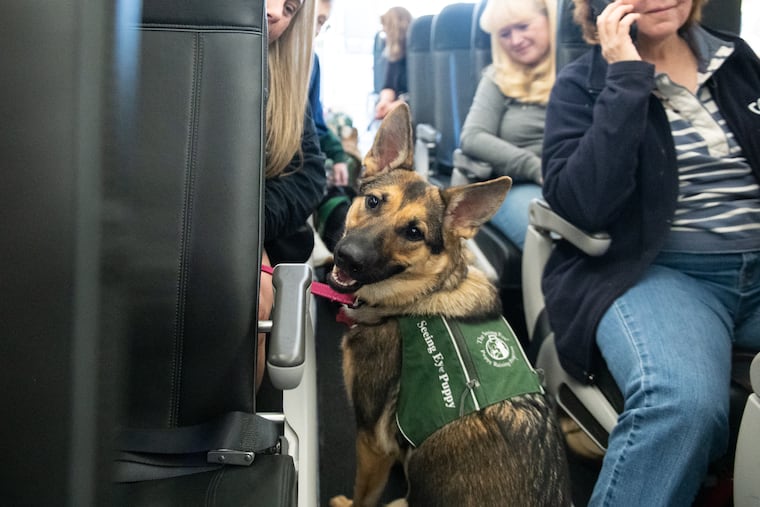Service puppies in training take on Philadelphia International Airport like seasoned travelers
The Seeing Eye pups are training to become guides for people with visual impairments. Because they aren't yet working animals, travelers were allowed to pet them. And they sure did.

Sniffing around with professionalism, a pack of service puppies went through airport security, found their gate, and boarded a plane all before nap time.
On Saturday, more than 40 golden retriever, Labrador, and German shepherd puppies from the Seeing Eye agency strolled through Philadelphia International Airport terminals with one mission: training to assist people with visual impairments.
Putting the TSA PreCheck line on a brief hold, these first-time travelers, all leashed up and in green vests, smoothly guided their trainers through security screenings and to departure gates with nary a growl, arguably more pleasant than many travelers.
They were on their best behavior walking from Terminal A to E, with occasional playful “woofs” evidencing their youth. Even busy travelers found it hard to resist their fluffy enchantment, with many stopping to ask if they could pet the pups or simply observing them with endearment.
Service dogs are not to be petted while they are at work, according to Kimberly Winnington, area coordinator for the Seeing Eye, a guide dog organization based in Morristown, N.J. But, because these pups are still training (a.k.a. off-duty) and getting used to environments like this, passersby were allowed to touch them.
» READ MORE: A Willow Grove family transformed their home into a haven for Seeing Eye pups
Abbey Isett’s toddler couldn’t help but gently approach a black Labrador pup, who tried to keep composed as his trainer reassured him the interaction was OK.
For Isett, whose husband has a genetic condition that is leading him to blindness, the scene was a heartwarming and reassuring moment.
“This is something we are going to have to look into in the future,” she said. “I love seeing this because it means [her husband] will still have the opportunity to travel.”
The Seeing Eye puppies are socialized by host families after they are around 7 to 8 weeks old, learning about basic house rules and interactions with humans, before going on to formal training and then being matched with people with visual impairments.
Despite receiving training, not all puppies go on to become guides, but about 60% of them will, Winnington said.
Four-month-old golden retriever Shallynn gave older pups a run for their treats, keeping up with them and only briefly plopping to the floor for rest breaks, wagging her tail as she took in the airport scene.
Her trainer, Curt Wolford, has been doing this for a decade and thinks Shallynn stands a “great chance” to become a guide dog.
“She is spot on, bright, healthy, good on the leash; not all puppies are,” Wolford said, describing Shallynn as a really special pup whose favorite toy is a squeaky iguana.
He hopes she gets a particularly affectionate forever family because she loves playing with children and giving them kisses until they giggle, Wolford said.
In the (unlikely) event she doesn’t become a guide, Wolford isn’t worried.
Puppies who don’t pass the program can be adopted by their host family. The 68-year-old himself already has a pup he adopted as part of this program seven years ago, and she (reluctantly) helps guide puppy trainees Wolford brings home.
Before Shallynn’s fluffy ears could finish taking in the cacophony of announcements and voices around her, it was time for the pups to board a flight to nowhere.
Ambling down the narrow boarding bridge, the pups and trainers boarded a Frontier Airlines plane for the experience.
“You are doing great; you are a good girl; you got this, Ruby,” trainer Lisa McBride reassured her black Lab as they walked to their seat.
McBride, a seasoned trainer, is looking forward to all the help Ruby will be able to provide someone. But her departure will undoubtedly be a heartbreak, McBride said.
“She is my baby,” McBride said. “But I do it so that the future blind person who gets her will be able to form that love connection with her.”
As seats filled up, Ruby and the other service pups calmly lay down without bothering one another.
That’s the difference between a service animal and an emotional support one, Winnington said.
Service dogs are trained to help people with disabilities navigate their environments. They are essentially at work when in public places.
“To give them this early exposure and have them experience it and get more comfortable with it really can build their confidence and increase their chances of success,” Winnington said.